Text
Something I regret about the Peter Jackson LORD OF THE RINGS movies is that they inevitably flatten and coarsen various aspects of the story: subplots are condensed or excised, plot elements simplified, action blown up, timeframes compacted, and characters sometimes made rather one-note. I don't think the results are bad — I have criticisms in spots, but it's faithful to the spirit of the book even in areas that one would expect to be difficult (like all the homoeroticism), and if some of its additions (like the dwarf-tossing jokes) are dumb, they make the movies work the way they need to for theatrical epics of this scale. In some ways, I think the movies improve on the story: The increased role of Arwen is welcome, and the movies create a sense of tension in character interactions that in the book are fairly cut-and-dried.
Still, there's a lot that's hard not to miss: Frodo's unjustified fear of Farmer Maggot, who turns out to be a brave friend; Bilbo's song of Earendil the Mariner; the way Rivendell and Lothlórien exist subtly outside of the normal flow of time; Gloin's account of Dain turning away the messenger from Mordor; Saruman of many colors; Gimli's courtly manners (the movie's version of him is a bit of a boor, but in the book, he's got the best manners of any of the major characters); Galadriel rejecting Celeborn's anti-dwarf prejudice; the subtler and more insidious treatment of Saruman's voice; Pippin's friendship with Beregon; the fate of Denethor and the palantír of Anor (which made a great impression on me as a kid); Éowyn's courage in facing the Lord of the Nazgûl (who in the book threatens to have her dragged away "to the houses of lamentation, beyond all darkness" to be tortured forever!); Aragorn's argument with Ioreth about the virtues and etymology of athelas; the escape of Saruman from Treebeard; Frodo's compassion for Lotho and Lobelia Sackville-Baggins and pity even for Saruman.
This is an area where Phil Dragash's superb (albeit unauthorized) Soundscape audiobook project, which I've mentioned before, really fills in a needed gap. It's enough like the movies, particularly the music, to evoke a similar vibe, but it's an unabridged performance, so it omits only the introduction and the appendices. As an unabridged version of a very large book, it's a big time commitment (at least three times the combined length all three Extended Editions), but there's much to savor.
2 notes
·
View notes
Text
Okay so people rightly make fun of LotR's maps and how cartographically and geologically implausible Middle Earth is, but I've not seen any discussion of the maps of middle earth from the pov laid out in the introduction to the books: LotR is supposed to be a translation of a translation of a transcription etc, of an original manuscript, from a time where there was no satellite imaging or other technology associated with mapmaking. The different societies operate at different levels of technological fashion, but none of them seem (to me) overtly to be the kind of society that would necessarily create maps of an accuracy that we expect in our era, or even in Tolkien's own era.
Does anyone know of such discussions? Surely other people have thought about this idea before.
On the one hand, you CAN take the creation story in the Silmarillion as literal fact for the purposes of LotR, and this means that natural geologic processes did NOT form Mordor's square mountain range, so the maps can be perfectly accurate for a non-realistic scenario.
On the other hand, there's no reason to take the maps as the literal truth, in the same way that the text is not intended to represent the unfiltered truth of the experiences of those stories. The Hobbit, LotR and the Silmarillion equate to the collected texts originally written by Bilbo, Frodo, and Samwise in The Red Book of Westmarch, which was written after the fact and then translated much later. For example, the character named Kalimac Brandagamba is rendered as Merry Brandybuck for the purposes of making the Hobbits and their names feel more familiar to English readers. A different example would be that during the Battle of the Pelennor Fields the narrator delivers us a song not sung *during* the battle, but which was written *about* the battle at some later date in order to demonstrate that the deeds of the heroes were considered valiant. So why would the maps be precise cartographical representations of Middle Earth in a time when that might not be necessarily expected?
#lord of the rings#lotr#maps#books#jrr tolkien#this seems a reasonable argument#incidentally in the 1981 bbc radio version of lotr#the battle of the pelennor fields IS presented as a ballad#sung by oz clarke and the ambrosian singers#it's a cool idea but the lyrics are often hard to understand
13 notes
·
View notes
Text
Abused by leaf
32 notes
·
View notes
Text
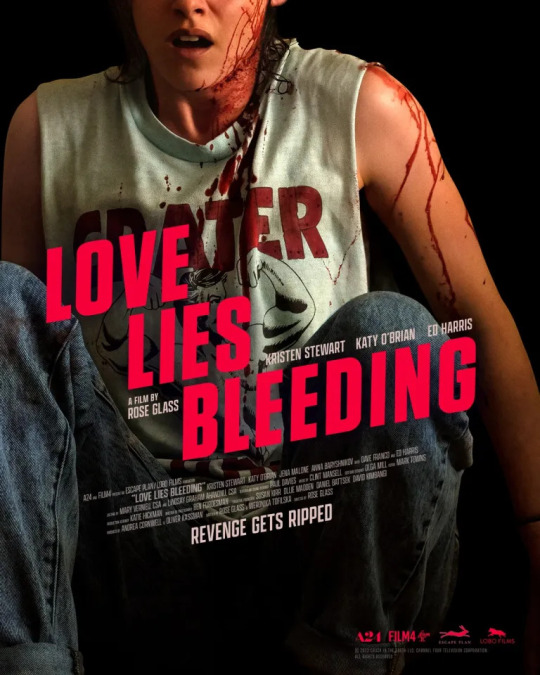
March 2024. What if a lesbian bodybuilding fetish vid were also a heavy-handed '90s PSA about the dangers of steroid use? What if it were also an incredibly brutal crime drama, and also a surreal sort-of werewolf movie in which Katy O'Brian has a vivid hallucination of vomiting up Kristen Stewart, drenched from head to toe in water-based lube? What if all three of the top-billed stars were afflicted with some of the most awful wigs ever seen in a moving picture? What if a mouse said this about a KIA Sorento? If you've ever asked yourself any of those pressing questions (and perhaps even if you haven't!), have I got a movie for you. CONTAINS LESBIANS? Yes indeedy! VERDICT: What, and I say this with all sincerity, the actual fuck was that?
#movies#love lies bleeding#rose glass#kristen stewart#katy o'brian#ed harris#lesbian movies#wlw#hateration holleration#come for the toxic lesbian fetish bait#stay for the array of brutal murders!#not dull but hoo boy#i realize that *most* of the hulking-out sequences were surely hallucinatory#but then there's the ending
5 notes
·
View notes
Text
In re: LOVE LIES BLEEDING: Well, that went some places. Not pleasant or especially coherent places, but full marks for audacity, I guess.
#movies#love lies bleeding#kristen stewart#katy o'brian#wlw#lesbian movies#it's surreal and far far more brutal than i had been prepared for#although it's really ed harris's wig that's going to give me nightmares#the whole thing is such a sustained exercise in WTAF that I don't even know where to begin#like i'm not even sure what genre to call that#except that it seems likely to be a cult movie
3 notes
·
View notes
Text

If they believe in themselves, I guess? The artist of this 1958 paperback edition of a Peter Cheyney Lemmy Caution novel (originally published in 1938) isn't credited.
4 notes
·
View notes
Text
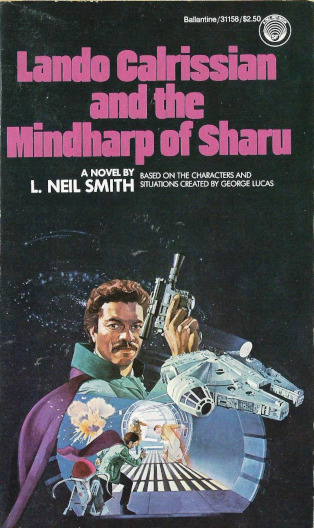


July, October, and December 1983. The success of the Brian Daley Han Solo trilogy led to a trilogy of novels about the adventures of Lando Calrissian prior to the events of THE EMPIRE STRIKES BACK, written by L. Neil Smith.
The first two novels, LANDO CALRISSIAN AND THE MINDHARP OF SHARU and LANDO CALRISSIAN AND THE FLAMEWIND OF OSEON, each follow basically the same formula: Lando is arrested on trumped-up charges and strong-armed into a dangerous quest, which proves much weirder than advertised (involving some surreal interludes) and turns out rather differently than anyone expects. In the course of these adventures, Lando makes a very dangerous enemy called Rokur Gepta, a strange being who is, or claims to be, a Sorcerer of Tund, a practitioner of Ancient Magics that Lando, naturally enough, assumes are entirely hogwash. In the third and final book, Lando comes to the aid of a race of manta-ray-like beings called oswaft, who live in deep space and can move at will through hyperspace — an early version of the purrgil space-whales of REBELS, albeit unequivocally sentient — and who are about to be wiped out by a military blockade.
Unlike in the movie SOLO, Smith's young Lando considers himself a gambler and con artiste, not a smuggler or soldier of fortune, making his living at sabacc (a game Smith invented for these books) and only very rarely carrying a weapon big enough to spoil the line of his cummerbund. After winning the Millennium Falcon just prior to the beginning of the first book, he's actually keen to unload the ship because he doesn't know how to fly, preferring to travel by luxury liner. Lando similarly acquires a droid who becomes his sidekick: Vuffi Raa, a mechanical starfish with his brain in his central body and five detachable tentacles that can alternatively serve as arm, leg, or "face." (This description apparently defeated cover artist William Schmidt; the droid on the cover of the first book does have tentacles, but doesn't otherwise resemble how Smith describes Vuffi.)
Smith, who died in 2021, was a Libertarian gun nut, but editorial pushback keeps that to a low boil in these novels, which makes them by far the most readable of Smith's books for anyone who's not a Libertarian crank. There's still a wry and cynical anti-authoritarian streak, however, which is perfectly appropriate for Lando Calrissian.
Smith's take on Lando is really the best part of these books. You get a clear sense of how being a professional gambler shapes Lando's outlook, and while he's not exactly heroic, you can see a nascent set of principles taking shape. Unlike Han Solo (who isn't mentioned in these novels), Lando is self-possessed but not cocky, and he's much less inclined than Han is to solve problems with violence.
The actual plots are rather strange (especially MINDHARP, whose storyline hinges on some very uncomfortable attitudes about indigenous peoples, which are eventually upended in a way that's even more uneasy), and include some departures from STAR WARS lore that are occasionally distracting. The latter were not Smith's fault (he said later that he'd been forbidden to even mention previously established characters or settings, and had to fight to be allowed to include the Millennium Falcon), but I'm not sure who should be blamed for the books' peculiar shortage of female characters. It's entirely possible that Lucasfilm and/or Ballantine were reluctant to even imply any kind of romantic subplot for Lando — antiblackness at work — but there are precious few women at all, and I think only one of them has dialogue in more than one scene.
While the Han Solo books were in many respects foundational to what became known as the "Star Wars Expanded Universe," the Lando Calrissian novels were often overlooked and treated disdainfully in later SWEU sources (for many years, Wookieepedia didn't even have synopses of them!), although there are a few references to these books in SOLO. Nonetheless, they're quite interesting and are notably better-written than most SW tie-ins. For all their plot oddities, they also remain the most thoughtful treatment of Lando, a character who was relentlessly marginalized and mistreated in the Bantam novels and most of the post-1986 comics.
#books#lando calrissian adventures#l neil smith#william schmidt#star wars expanded universe#star wars#lando calrissian#vuffi raa#rokur gepta#lando calrissian and the mindharp of sharu#lando calrissian and the flamewind of oseon#lando calrissian and the starcave of thonboka#antiblackness
7 notes
·
View notes
Text

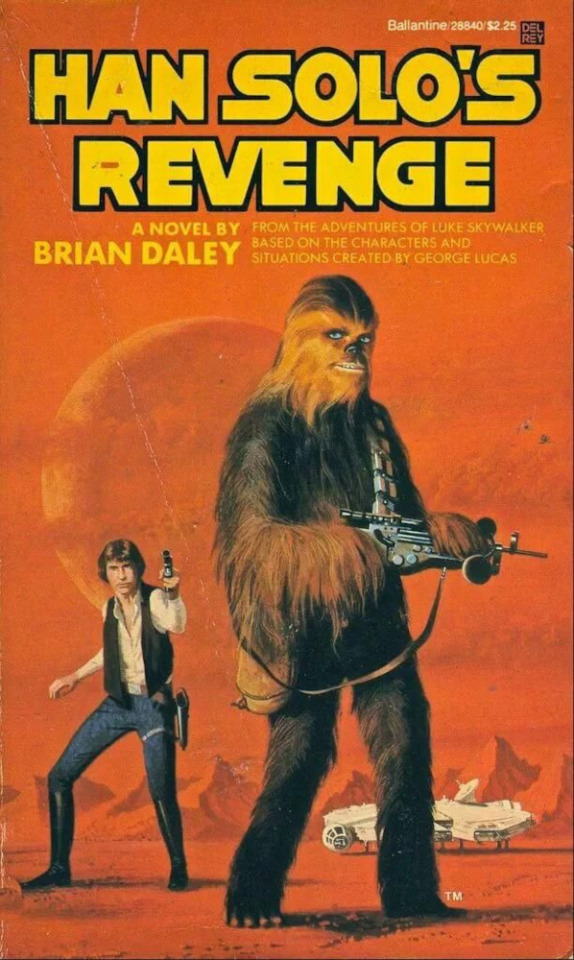

April 1979, October 1979, and August 1980. These novels by Brian Daley were not the first STAR WARS tie-ins, but they were the best of the early phase, and a strong influence on later SW media. The creative success of these exciting, frequently very funny books, which chronicle three adventures of Han Solo and Chewbacca prior to the first movie, had a lot to do with Daley himself. According to Daley's friends and his partner, novelist Lucia St. Clair Robson, Daley was Han Solo, or close to it: a brash military veteran with no love of authority, a fondness for sports cars and motorcycles, and a notoriously sarcastic sense of humor that concealed a heart of gold. Ironically, Daley, who genuinely loved STAR WARS, would have preferred to explore the history of the Jedi, but Lucas declared that off-limits, and imposed many restrictions on what Daley could and couldn't use from the films. For that reason, the novels take place on the fringes of the Empire: The first two books are set in the Corporate Sector, a region administered semi-autonomously by corporate interests with their own ruthless Security Police (an idea that clearly inspired some of the plot of ANDOR), while the third is set in the Tion Hegemony, a remote principality.
HAN SOLO AT STARS' END has Han and Chewie roped into aiding a group of people whose relatives have been "disappeared" by the Corporate Sector Authority, which is quietly rounding up dissidents and sending them to a secret facility called Stars' End. After Chewbacca is captured by the Security Police, Han concocts an elaborate, harebrained scheme to rescue his friend and the other "lost ones" from the galaxy's most closely guarded high-tech prison. Naturally, things don't go quite as planned, leading to a spectacularly ludicrous finale. (Spoiler: Han accidentally launches the prison complex into space.) This novel was subsequent adapted for the STAR WARS newspaper strip by Archie Goodwin and Alfredo Alcala, although the adaptation unfortunately isn't a patch on the original.
HAN SOLO'S REVENGE finds Han and Chewbacca, desperate for cash, taking a job that turns out to involve transporting slaves. This is a line our heroes will not cross, so after dealing harshly with the slavers, Han agrees to help a Corporate Sector Authority auditor named Fiolla of Lorrd track down the ringleaders of the operation, one of whom is her once-trusted assistant, Magg. Meanwhile, Chewbacca is forced to contend with a stubborn skip-tracer called Spray, who is determined to repossess the Millennium Falcon over Han and Chewie's unpaid bills!
HAN SOLO AND THE LOST LEGACY has Han and Chewbacca agreeing to help Han's old buddy Badure, Badure's friend Hasti, and an academic named Skynx locate a legendary lost starship, the Queen of Ranroon, the fabled treasure ship of an ancient tyrant called Xim the Despot. (The skull on the cover is Xim's emblem.) Although this sounds like it was influenced by RAIDERS OF THE LOST ARK, the book was actually published almost a year before the premiere of RAIDERS.
Although the novels make clear that Han is not overly fond of droids, the books give Han and Chewbacca a pair of droid companions: a laconic old labor droid called Bollux, and a small, extremely sophisticated, disconcertingly enthusiastic computer probe called Blue Max, who "lives" within a compartment in Bollux's chest. Here's how Alfredo Alcala depicted them in the comic strip:

Daley also includes some delightful aliens, including the skip-tracer Spray, who's a Tynnan — basically a sentient beaver with the dexterity of a raccoon — and the Ruurian academic Skynx, a sentient caterpillar who's determined to complete as much of his research as he can before entering the next phase of his life cycle and becoming a chroma-wing who'll have little memory of his former identity.
A useful companion for the first two books is Michael Allen Horne's HAN SOLO AND THE CORPORATE SECTOR SOURCEBOOK for the West End STAR WARS RPG, published in 1993:

Aside from the inevitable game statistics and some quite decent illustrations of the novels' characters, the sourcebook fleshes out Daley's conception of the Corporate Sector Authority, explaining how the Corporate Sector functions and its relationship to the Empire. This is narrated in part by Han Solo himself, which is presented as excerpts of later interviews with an Alliance historian named Voren Na'al (a common conceit in the WEG game books that works especially well here). The sourcebook is best read after the novels, since it explains their plots in detail, but it's a worthwhile supplement. Unfortunately, a planned followup describing the Tion Hegemony was never published before West End Games lost the SW license.
Brian Daley's other major contribution to STAR WARS lore was scripting the NPR radio adaptations of the first three movies. STAR WARS originally aired in the spring of 1981, THE EMPIRE STRIKES BACK two years later. Daley also wrote the later adaptation of RETURN OF THE JEDI, but he died of cancer in early 1996, at the age of 49, so the final drafts were completed by John Whitman.
#books#star wars expanded universe#han solo adventures#brian daley#wayne douglas barlowe#dean ellis#william schmidt#han solo#chewbacca#corporate sector authority#archie goodwin#alfredo alcala#star wars andor#star wars
15 notes
·
View notes
Text
It says a lot about Tolkien, I think, that the only civic institutions the Shire has that are more than merely ceremonial are the post office and probate court.
In an undated letter written in the late 1950s, reproduced in THE LETTERS OF JRR TOLKIEN, Tolkien alludes to the legal difficulties Sam faced after returning from the Grey Havens at the end of LORD OF THE RINGS:
When Master Samwise reported the ‘departure over Sea’ of Bilbo (and Frodo) in 1421, it was still held impossible to presume death; and when Master Samwise became Mayor in 1427, a rule was made that: ‘if any inhabitant of the Shire shall pass over Sea in the presence of a reliable witness, with the expressed intention not to return, or in circumstances plainly implying such an intention, he or she shall be deemed to have relinquished all titles rights or properties previously held or occupied, and the heir or heirs thereof shall forthwith enter into possession of these titles, rights, or properties, as is directed by established custom, or by the will and disposition of the departed, as the case may require.’
You can see how the residents of Hobbiton might have seen Sam's return as the premise of a kind of Agatha Christie mystery plot: favorite servant of eccentric middle-aged local resident departs on an unexpected journey with his master; returns home alone two weeks later; and then conveniently produces a copy of said eccentric local resident's new will, naming the servant the heir to all his property — and the only account the servant can offer of his master's whereabouts is a preposterous story about Elves. Suspicious! Very suspicious indeed!
85 notes
·
View notes
Text
By far the best bit in MY NAME is a sequence in the fifth episode where Ji-woo runs into a cop from another unit who recognizes her from the aftermath of her father's murder, realizes that she's using an assumed name, and then … unexpectedly covers for her to her boss. She confronts him in the parking lot to ask why, and he just laughs it off. He has an inkling what she's up to, but his reaction is, "What would I gain from exposing you? It'll just be a pain in the ass." And that's it; nothing else comes of it and he doesn't reappear, having stuck to his conclusion that it's not his problem and it would be funnier just to leave her to whatever she's doing.
If the show had had more moments like that, it would have been a lot better, and perhaps more successful in being its own thing rather than just a mashup of bits from better-known crime dramas.
#teevee#my name#hateation holleration#this is also the only time anyone in the show seems like a real cop#“some other cop is doing something weird and shady? i pretend i don't see it!”
1 note
·
View note
Text

MY NAME (2021): Pulpy, violent, derivative Korean crime drama about a young woman named Yoon Ji-woo (Han So-hee) who sets out to avenge the murder of her gangster father by joining the gang of which he was a member and then, at the behest of the organization's crafty boss, Choi Mu-jin (Park Hee-soon), infiltrating the Inchang Metropolitan Police under an assumed name to find her father's supposed killer, a senior narcotics cop (the avuncular Kim Sang-ho).
The plot (whose major beats you'll likely anticipate just based on the preceding synopsis) is kind of a gender-swapped riff on the Hong Kong film INFERNAL AFFAIRS (remade in the U.S. as THE DEPARTED), with some echoes of John Woo's Hong Kong classics (in particular HARD-BOILED), albeit executed with far less thematic unity. There are some stylish moments, but MY NAME never finds a consistent groove, and it only occasionally goes hard enough to compensate for its awkward pacing, clunky structure, and numerous lapses in plausibility and plot logic. Only in the finale does the show serve up the emotional grandiosity needed to give the bloodshed some real juice, and it's still let down somewhat by a weak coda.
Park's cool charisma is a major load-bearing element throughout, but Han, curiously, is more convincing in the action scenes than the quieter moments, perhaps because the scripts struggle to give Ji-woo (or any of the show's very few female characters) any meaningful interiority. An ill-advised early time-skip also undermines the clarity of her motivations and priorities, which too often leaves her seeming like a supporting character in her own story. CONTAINS LESBIANS? There are barely any women other than Ji-woo. VERDICT: Moderately diverting if you can stomach the brutal violence, but even its strongest moments feel recycled from earlier, better examples of this genre. CWs apply for attempted sexual violence in the first two episodes, and episodes six and seven include some scenes of graphic self-harm.
#teevee#hateration holleration#my name#han so hee#park hee soon#ahn bohyun#a gender-swapped variation on hard-boiled etc would be fine#but this show really struggles to know what to do with its heroine#other than kick the mortal shit out of her#the male characters constantly grab the spotlight#with choi mu-jin he is at least a central character#but any time there's some dude on the screen that isn't just a random goon for ji-woo to beat up#you can bet he will dominate the scene#while han wonders what her character's motivation is supposed to be
1 note
·
View note
Text
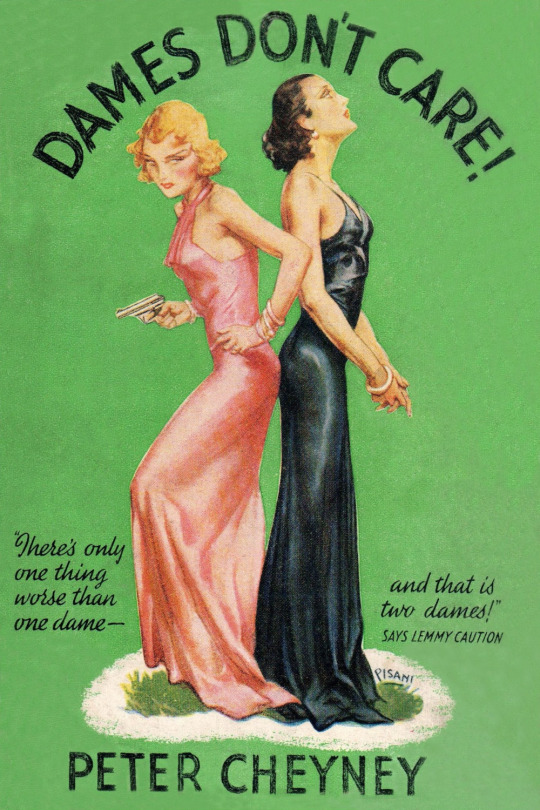
John Pisani cover for the second Lemmy Caution novel by Peter Cheyney, originally published in 1937.
#books#pulp cover#john pisani#peter cheyney#dames don't care#lemmy caution#it's true — dames don't care (except when they care too much)
9 notes
·
View notes
Text
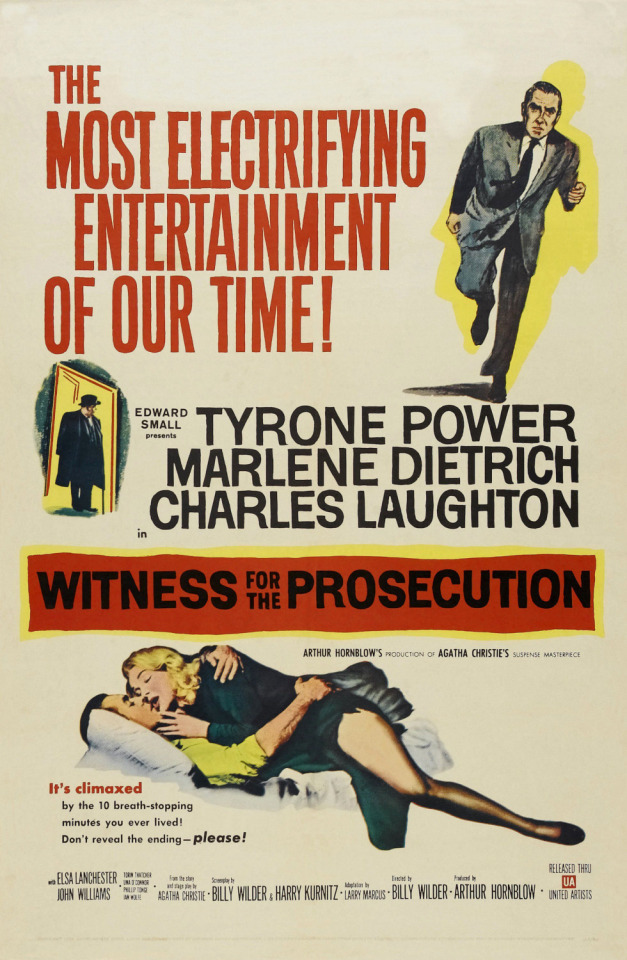
December 1957. Billy Wilder's finest hour: a most superior adaptation/expansion of the Agatha Christie courtroom drama, starring Charles Laughton at his grumpiest as ailing barrister Sir Wilfrid Robarts, a self-described "mean old man who hates to lose" defending the seemingly hapless Leonard Vole (Tyrone Power) from charges of murdering an elderly woman he'd befriended (Norma Varden).
As Sir Wilfrid's long-suffering nurse (Elsa Lanchester) tries to keep him from dropping dead of "conduct unbecoming a cardiac patient," the Vole case is complicated by the arrival of Leonard's wife Christine, a hard-bitten German immigrant (Marlene Dietrich) who seems curiously eager to send her husband to the gallows.
An audacious, moderately sordid mystery plot is greatly enlivened by dynamic direction and a marvelous script full of witty dialogue that frequently makes even the secondary characters (like Francis Compton as the good-humored judge and Una O'Connor as the murdered woman's peppery housekeeper) a delight to watch. The climactic moments go over the top just a tad, but it's thoroughly entertaining, by far the best adaptation of the popular stage play.
#movies#hateration holleration#witness for the prosecution#agatha christie#billy wilder#charles laughton#tyrone power#marlene dietrich#elsa lanchester#una o'connor#by “just a tad” i mean “an awful lot”#but it's very hard to complain#probably the best feature adaptation of a christie story#christie thought so and i think she was right
3 notes
·
View notes
Text
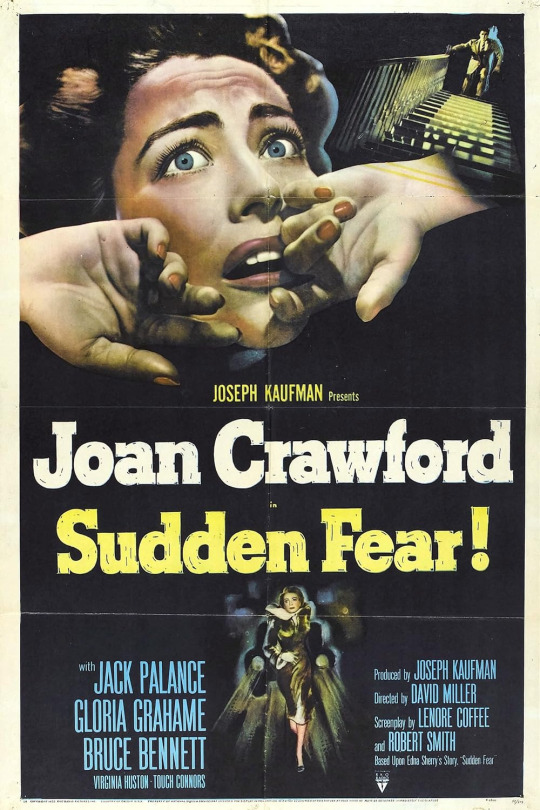


Haterating and hollerating in the 1950s:
SUDDEN FEAR (1952): Inventive but unsatisfying thriller about a middle-aged playwright and heiress (Joan Crawford) who discovers that her new husband (Jack Palance) and his ex-girlfriend (Gloria Grahame) are plotting to do away with her, and decides to concoct her own elaborate trap for the would-be killers, which doesn't go as planned. Palance is well-cast, walking an interesting line between charm and sociopathy, and the film gives Crawford one of her better '50s roles, but the script fails to pay off its own clever plot twists while allowing Crawford too many opportunities for her customary histrionics — particularly in a pair of over-the-top dream/fantasy sequences and in a crucial scene where the heroine has to express, without dialogue, that she's having second thoughts about her own plan. The finale, while undeniably tense and featuring striking nighttime cinematography by Charles B. Lang Jr., also feels like it belongs in a completely different movie.
THE GIRL NEXT DOOR (1953): Bright, attractively staged Fox musical (with two animated interludes) about the burgeoning romance between a successful stage star (June Haver) and her handsome new next-door neighbor (Dan Dailey), a comic strip artist and widower with a young son (Billy Gray) who's none too happy at this new competition for his father's attention. Haver and Dailey are great, and their easy repartee is very appealing. It's also interesting to see Dennis Day outside of his more familiar role as Jack Benny's idiot stooge. However, Billy Gray's character never quite rings true; there's no real reason for Joey to dislike the charming, good-humored Jeannie other than childish jealousy, so the story depends on his eventually getting over it rather than on Jeannie winning him over, which might have been more fun.
A SUMMER PLACE (1959): Overwrought Delmer Daves adaptation of a Sloan Wilson novel about two one-time lovers (Richard Egan and Dorothy McGuire), now unhappily married to others (Constance Ford and Arthur Kennedy), who decide to divorce their respective spouses so they can finally get married, only to face endless angst because their college-age kids (Sandra Dee and Troy Donahue) are also in love, in A Society That Just Doesn't Understand™. The story might have been considered daringly blunt by the standards of 1958–59, but to modern eyes, it succeeds mostly in putting the "turgid" in "dramaturgy." The script and direction are so unrelentingly heavy-handed that the actors seem like they're mining coal, with only Constance Ford (whose character is an unmitigated bitch) allowed to be anything other than laboriously tormented.
#movies#hateration holleration#sudden fear#joan crawford#jack palance#the girl next door#dan dailey#june haver#dennis day#a summer place#sloan wilson#delmar daves#sandra dee#troy donahue#richard egan#dorothy mcguire#constance ford#sloan wilson is best known as the author of the man in the gray flannel suit#a novel from which the tv show mad men borrows quite shamelessly#(it was made into a popular but so-so movie with gregory peck)
7 notes
·
View notes
Text
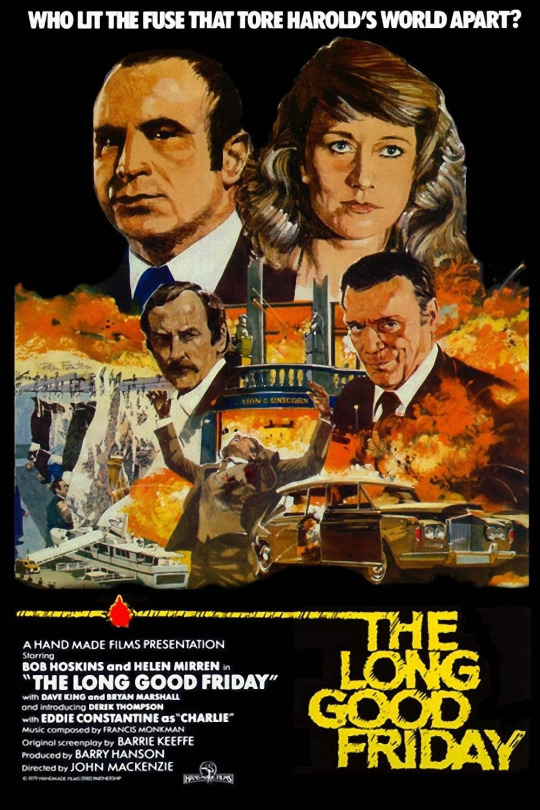
November 1980. Bob Hoskins channels the spirit of Edward G. Robinson in this engrossing British crime drama about an ambitious Cockney gangster who's preparing to take his business international with the help of his savvy mistress (Helen Mirren), only to have his organization start to crumble beneath him at the worst possible moment, for reasons he doesn't understand until it's far too late.
Flavorful, tough, and dynamic, anchored by the charismatic performances of Hoskins and Mirren. Among the cast of familiar British character players, watch for a young Pierce Brosnan in a small but very significant supporting role. CONTAINS LESBIANS? No, although Harold is surprisingly open-minded about his gay associates. VERDICT: Satisfyingly solid, and one of Hoskins' best.
#movies#the long good friday#bob hoskins#helen mirren#pierce brosnan#eddie constantine#john mackenzie#barry hanson#hateration holleration#if the fellow under hoskins in the poster (p.h. moriarty) looks familiar#he was featured in guy ritchie's#lock stock and two smoking barrels#although this isn't anything like as glib as lsa2sb#if you think of it as a modernized edward g robinson gangster movie#you'll approach it with the right set of expectations
2 notes
·
View notes






